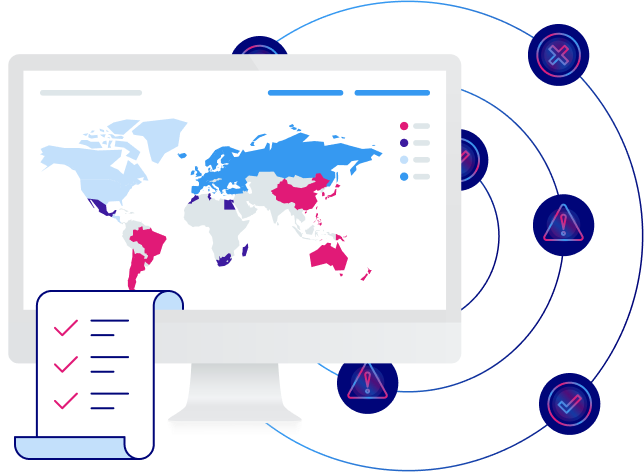-
Solutions
- AI Governance
- Geo-Specific Cookie Banner
- Consumer Preference Management
- Data Subject Request Automation
- Data Mapping and Vendor Risk Management
- Privacy, Vendor, and Risk Assessments
- Privacy Program Management
- Regulatory Guidance
- Privacy Program Consulting
- Certifications and Verifications
- International Data Transfers
Forrester TEI ROI of Privacy ReportTrustArc commissioned a Forrester study to analyze the potential benefits of using our platform and the Forrester team found ROI linked to efficiency, compliance, and decreased cost in data breaches.
Read the report -
Products Products Consent & Consumer Rights Overview
Experience automated privacy solutions that simplify compliance, minimize risk, and enhance customer trust across your digital landscape.
- Cookie Consent Manager Effortlessly manage cookie consent for global compliance, ensuring a secure, personalized browsing experience.
- Consent & Preference Manager Easily manage customer consent across brands and platforms—email, mobile, advertising—with a centralized repository.
- Individual Rights Manager Automate and streamline DSR workflows to ensure compliance and show your commitment to customer rights.
Products Privacy & Data Governance OverviewSimplify privacy management. Stay ahead of regulations. Ensure data governance with cutting-edge solutions.
- PrivacyCentral Centralize privacy tasks, automate your program, and seamlessly align with laws and regulations.
- Data Inventory Hub and Risk Profile Gain full visibility and control of your data and accurately identify and mitigate risks.
- Assessment Manager Automate and score privacy assessments like PIAs and AI Risk, streamlining your compliance workflow.
- Nymity Research Get instant access to the latest in privacy regulations, legal summaries, and operational templates.
Products Assurance & Certifications OverviewBoost brand trust with TRUSTe's certifications, showing your privacy commitment with the most recognizable seal, assessed by unbiased experts.
- Dispute Resolution
- TRUSTe Enterprise Privacy Certification
- TRUSTe EDAA Privacy Certification
- TRUSTe APEC CBPR and PRP Certification
- TRUSTe Data Collection Certification
- CCPA/CPRA Validation
- Data Privacy Framework Verification
- GDPR Validation
- Digital Advertising Alliance Validation
- Responsible AI Certification
-
Regulations
- EU General Data Protection Regulation (GDPR)
- California Consumer Privacy Act (CCPA)
- Virginia Consumer Data Protection Act (CDPA)
- NIST AI Framework
- ISO/IEC 27001
Data Privacy Framework (DPF)Transatlantic data transfer mechanism for EU-U.S., UK, and Swiss-U.S. commerce.
Learn more - Resources
- Contact us
TrustArc's Privacy & Data Governance Framework
The TrustArc Privacy & Data Governance (P&DG) Framework consists of operational controls that cover key privacy laws, regulatory frameworks, and requirements for ethics, compliance, and information governance programs.
About the framework
The TrustArc P&DG Framework is a controls-based framework that can be used by any organization looking for ways to align obligations across laws and regulations to support effective operationalization of privacy compliance and risk management.
Framework structure
The framework is organized by the three phases of building your privacy and data governance program – build, implement, and demonstrate. Under the three pillars there are 16 standards (that cover 55 controls):- Integrated Governance
- Risk Assessment
- Resource Allocation
- Policies and Standards
- Processes
- Awareness and Training
- Data Necessity
- Use, Retention, and Disposal
- Disclosure to Third Parties and Onward Transfer
- Choice and Consent
- Access and Individual Rights
- Data Integrity and Quality
- Security
- Transparency
- Monitoring and Assurance
- Reporting and Certification

Nymity Framework: Privacy & Data Protection Update in 7 States
Discover how to stay compliant and safeguard customer data as our panelists decode state-specific privacy laws, share best practices, and discuss data security risk management.
Achieve compliance
-
Privacy program development and compliance management Identify gaps and track compliance with PrivacyCentral – assess your controls and automatically get insights and reporting for a sustainable privacy program.
-
Guidance and operational templates Stay ahead of framework changes with expert guidance, ensuring your privacy practices remain compliant and up to date. Operationalize quickly with expert written operational templates for sample policies, checklists, and more.
-
Enterprise Privacy Certification Ensure your privacy management practices meet global standards and frameworks (FIPPs, OECD, and others).

The information provided does not, and is not intended to, constitute legal advice. Instead, all information, content, and materials presented are for general informational purposes only.




